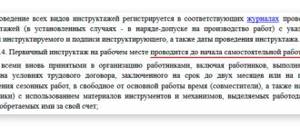In many organizations, an employee’s action such as absenteeism without good reason is regarded as a significant violation of local regulations.
Dear readers! The article talks about typical ways to resolve legal issues, but each case is individual. If you want to find out how to solve your particular problem , contact a consultant:
8 (800) 700 95 53
APPLICATIONS AND CALLS ARE ACCEPTED 24/7 and 7 days a week.
It's fast and FREE !
For such offenses, a disciplinary sanction may be imposed, and in some cases, a single absence can even lead to dismissal.
Concept
Initially, it is important to understand what characterizes the term “truancy.” In general, this is a long absence from work. In Russia, truancy can be considered:
- being late for work more than 4 hours;
- absence of an employee during the entire working day.
That is, if a person is absent from work for more than 4 hours (inclusive), the employer has the right to register absenteeism. But not always. Indeed, in Russia such a long absence without prior warning is sometimes not considered absenteeism.
What can be considered truancy and what is not?
Not any absence from the workplace contrary to the work schedule can be classified as absenteeism.
Leaving work early to go home, being late, delays after lunch - all these phenomena are unpleasant for the employer, but they are not absenteeism. Another thing is a long walk. Only absence for more than 4 hours and only for an unexcused reason will be considered absenteeism.
The Labor Code does not provide a list of reasons that can be considered valid. What makes the situation easier for the employee is that almost always such incidents are easy to confirm with documentation (a certificate from the hospital, the traffic police, the Ministry of Emergency Situations, a subpoena).
There are a number of judicial precedents (for example, Determination of the Constitutional Court of the Russian Federation of October 17, 2006 N 381-O), which clearly interpret the concept of “disrespectful reason”, guided by the general principles of the concepts of legal and disciplinary liability. When assessing the “respectability” of reasons, the situation is considered in its entirety. The employee’s general work behavior, his behavior before the situation arose, motives, and personal circumstances are taken into account.
Good reasons can be classified as follows:
- Subjective (concerns the employee’s personality: illness, participation in a court hearing, in investigative actions, calling the police).
- Objective (external circumstances: road accident, emergency situation with housing and communal services).
- Personal upon request. The employer is warned about such circumstances in advance: a wedding, the death of a relative, the birth of a child. The employee has the right to 5 unpaid days in such cases (Article 128 of the Labor Code of the Russian Federation).
Ambiguity of legislation
It is important to understand that in the Russian Federation, labor legislation does not always clearly interpret some aspects. And absenteeism is just such a component. What will you have to remember?
How to register absenteeism at work? The first step is to establish the fact of a long and, most importantly, unreasonable absence from work. If an employee warned his superiors in advance that he would be late/not come to work, then this scenario cannot be called absenteeism.
In addition, absence without warning for good reasons often cannot be documented as absenteeism. Therefore, employers and subordinates often meet in court to clarify the issue under study.
Excused Absence
How to properly register absenteeism at work? The very fact of establishing an unreasonable absence from the workplace plays a huge role here. As already mentioned, if there are good reasons, the employee does not have to worry about absenteeism and responsibility - they simply do not occur.
Often, valid reasons for absence from work include:
- illness of a subordinate;
- death of loved ones;
- circumstances beyond the control of the citizen (natural disaster, flight delay, etc.);
- road accident;
- child's illness.
This is not an exhaustive list. Typically, issues regarding absenteeism are resolved on an individual basis. Courts and employers themselves can assess the extent to which a subordinate’s absence from work is justified. But, as practice shows, in all of the above situations, the judiciary takes the side of the cadre.
When is it possible
The employer is forced to decide for himself what is considered a valid reason for absence from work and what is not. And the employee has the right to disagree with him, then the matter may go to court.
There is a list that the court relies on when deciding such issues. The Labor Code considers absence due to illness as one of them, but subject to the provision of a document from a medical institution.
The following are also considered valid reasons:
- performing public works;
- donation of blood and components;
- participation in a strike;
- transport problems - flight delay, car accident, etc.;
- force majeure, for example, disasters, natural disasters, military actions and others;
- detention;
- absence from work due to a delay in wages lasting more than 15 days (with prior notification by the employee to the employer).
From a practical point of view, it is more correct when an employee’s absence from work is agreed upon in advance with the employer. This is the case when a person, going on vacation or planning to take time off to which he is entitled, writes a statement about this.
According to the law, an employee is entitled to time off if:
- went to work on non-working days;
- donated blood and components;
- he has irregular working hours;
- is going to undergo a medical examination (one day every three years, and for employees of pre-retirement age - two days every year) or a mandatory periodic medical examination;
- intends to participate in the court hearing as a juror.
In response to the application, the employer issues an order.
Most employers are sympathetic to absences for family reasons:
- the need to care for a sick family member, most often a child;
- local utility failure at the place of residence;
- death of a close relative;
- wedding;
- moving;
- birth of a child, etc.
To avoid problems, we strongly recommend that you develop and communicate to your employees rules of conduct in such cases. If there is a risk of absence from work, the employee is obliged to inform his supervisor, and then he will receive instructions on what to do in this case so that his absence does not become absenteeism, for example, take some supporting documents. In many organizations, it is possible to work remotely, for example, if a child is sick. Whether or not to take sick leave in this case is discussed separately. It is important that employees know how to act to avoid problems.
About the features
The operation being studied requires enormous attention. After all, it has some features that not everyone knows about. Namely:
- If absenteeism is considered due to absence from work all day, then the employee must be assigned a specific place of work under the contract. When a subordinate, under an employment agreement, does not have a specific workplace, his presence anywhere in the territory of the enterprise cannot be considered absenteeism.
- The number of hours away from work plays an important role. If a citizen is 1.5 or even 3 hours late, then this scenario cannot be called absenteeism.
- Sometimes citizens use vacation and time off without permission. This is allowed if the boss did not provide days of rest when they are provided for by law. For example, a blood donor is required to be given time off the day after donating the biomaterial.
Perhaps this is all that is primarily important for the employer. Now you can consider in more detail the procedure for registering absenteeism.
Symbols in the time sheet
Most enterprises still use unified letter designations in the report card, since they are the most convenient to use and cover almost all situations.
Codes for working hours
The following codes are used to indicate working hours:
- “I” – denotes the employee’s performance of job duties in normal working mode;
- “N” – working hours from 22-00 to 6-00, that is, work at night;
- “RV” – going to work on weekends and holidays;
- “K” – the employee is on a business trip, regardless of whether it is a working day or a holiday;
- “C” – hours of overtime work, in cases where overtime can be determined only based on the results of the month, it is entered only in the final columns of the time sheet;
- “RP”, “VP” and “NP” - denote downtime in the working time sheet: due to the fault of the employer, employee and due to circumstances independent of the will of the parties, respectively.
These are the most commonly used codes.
Codes to indicate employee absence
To indicate the time when a person does not perform his official duties, the following letter designations are used:
- “B” - weekends and holidays when the employee rested;
- “B” and “T” - in the report card indicate temporary disability, paid and unpaid, respectively;
- “OT” – duration of annual paid rest (vacation);
- “OD” in the report card indicates additional leave, which is paid;
- “P” – this code denotes sick leave, which is given to a woman in connection with pregnancy and childbirth;
- “OZH” in the report card - the decoding of this code means leave granted to care for a child;
- “U” and “UD” – study leaves, paid and at your own expense, respectively;
- “BEFORE” - means vacation at your own expense, that is, without accrual of payment;
- “PR” – absenteeism established during an internal investigation;
- “NN” in the report card - the decoding of this code indicates the absence of an employee for unknown reasons. As a rule, it is subsequently replaced by one of the above reasons for absence from work.
You need to consider in more detail this type of time a person is absent from the workplace as time off. There is no designation for it on the report card. It will depend on how the time off is documented.
The fact is that there is no such concept as time off in the Labor Code of the Russian Federation; by default, this term refers to the following types of rest:
- Providing a day of rest at a time convenient for the employee, in the case when he worked on his days off (indicated by code “B”);
- One day provided to the employee at his own expense (indicated by the OD code);
- An employee’s absence from work by agreement with the employer, only upon application, without being reflected in the report card (will be reflected with the letter “I”). Although this case goes against labor laws.
In order to establish what type of time is reflected in the timesheet, letter codes are used. They can be found in the unified report card T-12. The employer is not obliged to use them, but can approve his own symbols.
>Designations and codes in the time sheet
Responsibility for absenteeism
How to properly register absenteeism for an employee? According to the Labor Code of the Russian Federation, a citizen can be held accountable. The employer decides how to punish a negligent subordinate.
The following options are possible:
- comments;
- reprimands;
- dismissal.
Usually, the last deal requires repeatedly violating the rules established by the company. But according to the law, an employer can dismiss an employee even for a single absence.
In addition, the boss can forgive the worker and not react in any way to the negligence of the subordinate. But in practice, this option is rare. How to register absenteeism at work?
About the design step by step
Doing this is actually not as difficult as it seems. Particularly if you follow this little guide. It will be presented to our attention below.
How to register a truancy? The instructions for completing this operation look something like this:
- Establish the fact that the employee is absent from the workplace.
- Prove that there are no valid reasons for not attending work.
- Demand an explanatory statement in writing from the subordinate. This is done during the employee’s first visit to the company after absenteeism.
- Complete the necessary documentation for absenteeism if the person did not have a really compelling reason for being absent from work. Further actions directly depend on how the boss decided to punish the negligent subordinate.
It is important to take into account that if a subordinate does not write an explanatory note, the superiors draw up a special act in which the mentioned violation is recorded. According to the Labor Code, explanatory notes after absenteeism are mandatory documents.
Documentation of employee absenteeism
So, we have figured out in what cases an employee’s absence from the workplace is considered absenteeism and how to prove it. How to document an employee’s absenteeism and its consequences?
The final decision on punishing an employee for absenteeism is made by the employer himself. An employee may be held liable for absenteeism in the form of:
- Layoffs. When dismissing someone for absenteeism, you do not need to draw up 2 orders - on imposing a disciplinary sanction and terminating the employment contract. An order to terminate the employment contract is sufficient. As the basis for such an order, reports, acts, explanatory notes from the employee, time sheets, that is, documents that prove the fact of absenteeism and justify dismissal, are indicated.
- Disciplinary action. It is issued by order of the head of the institution. This order does not have a unified form, so each enterprise can develop its own sample order. You can take the unified forms of other orders as a basis, so as not to forget to indicate all the necessary details in the document. For example, an order in form T-6 to grant an employee leave.
you can order in form T-6 on our website .
Such an order must reflect the following points:
- the fact of violation by the employee of labor discipline, that is, absenteeism itself, indicating its date;
- documents that prove the fact of absenteeism of the employee (memos, acts, explanatory notes from the employee, time sheets);
- type of punishment (consequences of violation): reprimand, reprimand, deprivation of another bonus, etc.
On our website you can form an order for disciplinary action. See the article “Disciplinary sanction order - sample and form” .
In order to, if necessary, punish an employee for absenteeism, the employer must, upon hiring, familiarize him with his job responsibilities (employment contract, job description) and internal labor regulations against personal signature. Then, after a decision on dismissal or disciplinary action is made, if the employee goes to court, there will be a greater chance that justice will side with the employer.
Dismissal
Let's start with the most “terrible” punishment - dismissal. How to register employee absenteeism under such circumstances?
The following papers will help you here:
- dismissal order;
- act of absence from the workplace of one or another employee.
The second document is drawn up in free form on paper. It serves as a kind of confirmation of absenteeism. Once completed, it is signed by at least 2 witnesses. The document reflects detailed information about absenteeism - date of incident, duration of absence from work, reasons (if any). The act also contains information about the truant.
If you plan to file a penalty for absenteeism, then a separate document is not required. In the appendix to the dismissal order, the employer indicates the need for penalties and relevant evidence.
How to register absenteeism at work in 2021?
In order for the employer's rights to be properly respected, absenteeism must be documented.
Otherwise, even if this fact is obvious, the employee will be able to challenge the imposed disciplinary sanction in court.
So, how to register absenteeism at work correctly?
With dismissal
The Labor Code of the Russian Federation establishes the right, and not the obligation, for the employer to cancel the employment relationship with the employee for absenteeism.
In addition to the most “strict” form of penalty, the following can be applied (according to Article 192 of the Labor Code of the Russian Federation):
- comment;
- rebuke.
Moreover, the employer can completely “turn a blind eye” to absenteeism without taking any disciplinary measures.
If, nevertheless, the manager decided to use a last resort measure, then how to formalize it correctly?
To do this you need to act step by step:
- prove the fact of the employee’s absence (perform photo and video recording, attract witnesses, etc.);
- when the employee first appears at work, demand written explanations;
- If, based on the text of the explanatory note, a conclusion has not been drawn that the reason is valid, you should proceed with the preparation of documentation about absenteeism.
According to Art. 193 of the Labor Code of the Russian Federation, the explanatory note is a mandatory document. If the employee has not provided this document within two days, the employer makes a corresponding act.
Documents and their samples
How to document absenteeism?
When dismissal for absenteeism, two documents are drawn up:
- act on the absence of an employee on site;
- dismissal order.
The act is written in free form or on the organization’s letterhead. The document is signed by witnesses (at least two). It is necessary to indicate the date and place of compilation, the nature of the situation, the time of the employee’s absence, his full name, reasons (if known).
Yes, by the way, it is not necessary to draw up a separate order to impose a penalty and an order to dismiss. The appendix to the dismissal order will contain documents confirming the legality of dismissal on this basis (memos, absence report, time sheet, etc.).
Sample documents:
Absenteeism report
Order of dismissal for absenteeism
Deadlines
The terms of dismissal for absenteeism in 2020-2017 are regulated by Art. 193 Labor Code of the Russian Federation.
The provisions of this article say that dismissal can be made no later than 1 month after the fact of absenteeism is recorded.
You cannot be fired for absenteeism if more than six months have passed since the actual absence. If an audit or audit was carried out at the enterprise, and the fact of absenteeism was revealed, then dismissal can be done no later than 2 years from the date of the offense.
Forced absenteeism - what is it? Read our article. How to fire a single mother for absenteeism? Find out here.
On the report card
Absenteeism can be noted two times on the report card:
| Situation | Mark |
| After drawing up the act, but before clarifying the reasons for the absence | NN (absence from work due to unknown circumstances) |
| The employee provided supporting documentation | For good reason, the NN in the report card is corrected to the appropriate mark (for example, to B, if the employee provided a certificate of incapacity for work) |
| The reason turned out to be disrespectful, or the employee did not provide supporting documents to the employer at all | PR (truancy) |
No dismissal
No one obliges an employer to fire an employee. After all, dismissal for a single absence, even without a good reason, can deprive the employer of a valuable and promising employee.
Maybe we should give him an opportunity to improve?
Documents and their samples
Since the Labor Code of the Russian Federation provides for only three types of penalties:
- comment;
- rebuke;
- dismissal.
Then no other rules can be applied (a common misconception is a severe reprimand or entering it in a personal file).
When reprimanding, the documents will be as follows:
- order of reprimand;
- certificate of absence.
Example of an order:
It will still be necessary to obtain a written explanation from the worker before starting the disciplinary process. If an employee refuses to give any explanation, the corresponding refusal is recorded in a separate act.
Deadlines
The deadlines for applying a reprimand or reprimand are the same as for dismissal. That is, the employer must ensure that the relevant documentation is prepared no later than 1 month from the date the misconduct occurred.
On the report card
Regardless of the type of disciplinary sanction that the employer decided to apply for absenteeism, the mark “PR” is placed on the report card.
In the future, it can be corrected if a circumstance suddenly becomes clear that can be considered valid.
Without disciplinary action (reprimand)
Whether or not to apply a disciplinary sanction is a personal matter for the employer. But how to draw up documents if the head of the organization is ready to “forgive” an employee for a serious offense?
Documents and their samples
Since all documents drawn up upon absenteeism are drawn up to confirm the imposition of a disciplinary sanction specifically for this offense, if the employer wishes not to take any measures, acts, orders and other documentation are not drawn up.
Deadlines
The employer can still impose penalties, even if he previously decided to do otherwise.
The standard period is 1 month from the date of discovery of the offense.
It should be noted that in the absence of a drawn up act, it will be quite problematic to prove the fact of absenteeism. This, however, does not prevent you from using witness testimony after some time.
On the report card
Absenteeism without disciplinary action is noted on the report card in the standard way - “PR”.
Is payment for forced absence due to illegal dismissal required? Read about the dismissal of an employee who has not completed the probationary period here.
How to quit after maternity leave? Find out here.
Restrictions on dismissal
How is absence from work properly documented? A special act is drawn up, which is then given to several witnesses to sign. If a citizen is going to be fired for absenteeism, then several more important points need to be taken into account.
For example, such punishment is provided only for a certain time. You cannot fire an employee if more than 6 months have passed since the actual absence. During audits and inspections, dismissal is permitted no later than 24 months from the date of the misconduct.
Step-by-step procedure for dismissal for absenteeism
The step-by-step instructions for dismissal for absenteeism provide the following procedure for going through all stages: from committing an offense - absenteeism - to the final entry in the work book.
It is important to comply with all procedural formalities to avoid litigation. After all, if the procedure for actions and paperwork is violated, the dismissal may be declared illegal in court, the employee may be reinstated in his position, and the employer may be required to pay compensation.
So the procedure for how to properly fire an employee for absenteeism:
- Document the fact of absenteeism. This can be done by drawing up an employee absence certificate. The act is drawn up in the presence of witnesses (2-3 people). It is also permissible if the immediate supervisor submits a report on the commission of an offense to his subordinates to higher authorities.
- Request clarification from the employee. An explanatory note must be drawn up only in writing. Verbal explanations are not suitable. Duration – 2 days.
- Based on the results, either the official investigation is closed or a report is drawn up. Also, if there are no explanations from the employee within 2 days, a corresponding act is drawn up (Article 193 of the Labor Code of the Russian Federation).
- A decision is made to impose penalties. The right to fire for absenteeism is not an obligation, that is, the employer may not fire the employee, but apply another type of penalty.
- A dismissal order is being prepared.
- Familiarize the employee with the order.
- Record your dismissal by making an entry in your work book.
Nuances of action during long absences
The situation when there is a long walk deserves special attention. When dismissing someone for long absence, the step-by-step instructions are almost the same as for normal dismissal, that is, there are discrepancies:
- Record absence: draw up an act, enter data into the working time sheet.
- Draw up a notice of the need to appear and provide explanations.
- Send notice to the employee at a known postal address.
- After receiving notification of delivery, wait 2 days + the period required for delivery of correspondence.
- If explanations are not provided and confirmation of receipt of the notification, draw up a report.
- Take measures to determine the reasons for absence if notification has not been received. This stage is not mandatory, but recommended to avoid problems in a possible lawsuit later. You can make calls to the employee’s relatives and get their testimony.
- Draw up a report on the activities carried out, recording the information received. Optional.
- Issue a dismissal order.
- Draw up a report on the impossibility of familiarizing the employee with the order.
- Enter information into the work book.
- Make payment calculations.
- Send a notification to the employee about the need to obtain a work book.
Due to the fact that the law establishes a period for disciplinary punishment of 1 month, it is necessary to carry out all actions as quickly as possible. Considering that letters are returned to the sender after a month of storage, we recommend sending a telegram asking for clarification.
It would also be reasonable to draw up daily reports of the employee’s absence during the entire period of absenteeism, or to record this in another accessible way, for example, by making notes in the arrival and departure log, in order to comply with the procedure for dismissal for absenteeism without a good reason.
Preparation of procedural papers
The first document that needs to be prepared is confirmation of the fact of absence. The most common option is to draw up a report, although a report can also be used, based on the results of which an official investigation is opened. After requesting an explanatory note, you must wait two working days. Immediately on the day of absenteeism, it is impossible to issue a dismissal order for absenteeism sample and terminate the employment contract.
As part of the investigation, a decision may be made to dismiss for absenteeism without a valid reason if the employee refuses to provide an explanation for why he was absent. Or he did not confirm the documented reason, even if he considers it valid. An act should be drawn up about this.
You can download a sample act of dismissal for absenteeism by clicking on the link.
Requesting an explanation personally from an employee can sometimes be problematic. For example, if the employee never came to work. In this case, it is necessary to notify the employee of dismissal for absenteeism (sample) in case of refusal to provide explanations for his actions. Notification is sent via mail. You can notify by registered mail or telegram. The two-day period must be counted from the date of receipt of the notification by the employee.
After completing the investigation and establishing the reason for the absence, or if an explanation was never given by the employee, a decision is made to apply a penalty. The result is an order for the employee to take absenteeism (for 2021) and apply a disciplinary measure. If management decides to fire an employee, then there is no need to issue two separate orders - for dismissal and for discipline. One thing is enough - a sample. The employee must be familiarized with the order within 3 days. If you refuse to familiarize yourself, you must draw up a corresponding act.
Compliance with time periods
In addition to collecting and completing the necessary documents, it is important to meet the deadlines for specific events. The period during which a penalty can be applied is a month from the date of the offense. That is, you cannot fire someone for absenteeism after a year. However, in a number of cases, the course of the period is interrupted due to circumstances beyond the control of the parties. This could be: illness or vacation of an employee, during which it is impossible to dismiss. But the maximum extension period established by law is 6 months (Article 193 of the Labor Code of the Russian Federation).
date of dismissal
If there is a dismissal for absenteeism, then on what day should the dismissal take place? Not an easy question. To make a decision, you must be guided by Art. 84.1 Labor Code of the Russian Federation. According to its contents, the employee’s last working day is the date of his dismissal, if for other reasons there is no place assigned to him. In the case of absenteeism, the last day that the employee worked was the day before the day of absenteeism, unless a valid reason was confirmed.
Therefore, if the absenteeism was a one-time occurrence and the employee subsequently appeared and gave explanations that were regarded as an unjustifiable reason, the date of dismissal and the order to dismiss for absenteeism will correspond to the day the explanatory note was received. if the absenteeism is of a long nature, the employee’s daily absences are confirmed by reports and time sheets, and explanations were never received, then dismissal is allowed on the last working day. However, dismissal dated on the day of drawing up the final act of lack of explanation will not be a violation.
Registration of a work book
Entering data into the work book is the final stage of dismissal. If you don’t know or are not sure under what article one is fired for absenteeism, then dismissal for absenteeism is regulated by Article 81 of the Labor Code of the Russian Federation. Information is entered into the employee’s work book based on the order. The registration data of the order itself is written in the column “Name and date of the document.” Sample entry in the employment record about dismissal for absenteeism:
First, the number of the serial entry is indicated; the deadline is not missed. Next, the date for entering the information is specified, which must coincide with the date of dismissal and issuance of the order. Next, the dismissal for absenteeism is indicated in words in the labor record (Article 81 of the Labor Code of the Russian Federation). Afterwards the signature and title of the position of the responsible person are affixed. The record is certified by the company seal.
Sometimes an employer can terminate a contract and fire not for absenteeism, but if the employee is recognized as dead or missing. To do this, it is necessary to have a court decision (here details about the procedure for filing an application to the court) confirming this fact. The employer can initiate the process himself, or another interested party, for example, a relative, will file a claim.
The entry in the work book will look like this:
About reprimands
Most often, in reality, the phenomenon being studied does not entail complete removal from work. An employee may be reprimanded, for example.
Now we understand when dismissal for absenteeism is possible. The reasons for this phenomenon are different, but the main thing is that the employee does not have valid reasons for absence from work.
It's easier to reprimand. In this case, the following documentation will be required:
- reprimand order;
- act of truancy.
Otherwise, the process is no different from dismissal. Unless, in the end, the citizen faces removal from work duties and termination of the contract. Instead, the employee is punished in some other way. For example, bonuses are not paid for a certain date. In this case, you will have to put o (absenteeism) on your work report card.
The most important moments
In order for absence from work to be recognized as absenteeism under the law, the following must be done:
- The fact of non-appearance must be recorded in an act. No court will listen to an employer who has not bothered to properly document the employee’s absenteeism, and will be on the employee’s side.
- The employee was absent strictly for more than 4 hours. Please note: if he was absent for 3 hours 59 minutes or exactly 4 hours, this is not absenteeism.
- The reason for no-show, delay or early departure is not valid. That is, there are no documents or witnesses proving the validity of the reasons. The only exception is a pregnant woman. If a woman was absent “in pregnancy” or on maternity leave, a disrespectful reason will not achieve anything. You cannot fire such an employee.
- The employee was not at work. Unfortunately, this term is very difficult to interpret unambiguously. The position of the Supreme Court on this matter is as follows: the employment contract must clearly state the name of the organization and indicate the area in which it is located, the employee is assigned his labor functions and the place where they are performed (this can be a branch of the organization).
Situation: Nikolay N.N., an engineer at a company producing disposable tableware, spent 5 hours of working time, not in his personal account, but on the territory of the plant in a closed workshop.
The manager did not see him during this period, could not contact him, and suspected unauthorized absence. Even proper documentation of the employee’s absenteeism will not help in this case, especially if there are witnesses who will confirm that he performed his functions. Issues of dismissal for absenteeism are regulated by Art. 81 Labor Code of the Russian Federation. This provision establishes the right of the employer to dismiss an employee who has “missed work”, but not the obligation.
About deadlines
How to properly formalize dismissal for absenteeism? How long does it take to prepare the relevant documentation?
According to the Labor Code of the Russian Federation, it is necessary to carry out the operation within 1 month from the date of violation. The same period applies to reprimands and penalties. If the employer decides to leave the mentioned operation “for later,” then certain problems may arise in the future. To the point that no punishment can be applied to the employee.
Forgiveness
What to do if the employer decides to forgive the subordinate and not punish him to one degree or another?
This arrangement causes the least amount of trouble. According to the Labor Code, all previously listed documentation is used for disciplinary sanctions and reprimands. This means that the boss may not document absenteeism in any way.
The only thing that occurs most often in practice is explanatory ones. It is possible, but not necessary, to ask the employee to clarify the situation. It is possible that a day of work was missed for good reasons.
What mark is used in this case on the worksheet? It is enough to simply put “PR” in it.
Truancy
Absenteeism may become one of the grounds for terminating an employment agreement at the request of the employer.
Absenteeism is the absence of an employee from his assigned place without a satisfactory reason for 4 or more hours in a row during one day (shift). Nothing depends on the length of the shift (the employee skipped working hours). The boss can define the following points as absenteeism:
- When an employee who has signed an employment contract (term unspecified) leaves his workplace without satisfactory reason, without notifying the employer of termination of the agreement, before the expiration of the 2 week notice period;
- When an employee who has signed a contract (fixed term) leaves the position without any valid reason before the expiration of the contract or before the expiration of the warning period for early termination;
- Self-management of days off, as well as arbitrary assignment of vacation.
These norms may seem to be clearly defined and extremely transparent. However, employers, and often the courts, even today find themselves at a dead end when studying such cases and determining whether a particular situation constitutes truancy. As a result, judges' verdicts often turn out to be incorrect and hasty.
In the work book
If you still decide to fire an employee, you will have to establish the real reason for his absence from work. What mark to put in the work book?
How to register absenteeism at work (the step-by-step procedure was presented to our attention) is clear. In this case, you will have to put a corresponding note in your work book. Above is a sample of it.
About pregnant women at work
In addition, it is important to take into account that it is prohibited to fire pregnant women for absenteeism. The Labor Code of the Russian Federation protects women in an interesting position. In this case, it is possible to terminate the employment relationship at the initiative of the employer only when it comes to liquidating the company.
However, the law does not prohibit imposing disciplinary sanctions on pregnant women if they simply missed work. It is extremely difficult to prove that the employee has no valid reasons for such an action.
Symbols in the time sheet in 2021
The report card can use alphabetic or numeric codes to indicate a particular event, for example, attendance at work has the letter I or 01 in digital expression, absenteeism - PR or 24, additional days off without pay - NV or 28.
Timesheet codes (2019) - a complete list of alphabetic and numeric characters - are contained on the first page of Form T-12.
| Code | ||
| alphabetic | digital | |
| Duration of work during the day | I | |
| Duration of work at night | N | |
| Duration of work on weekends and non-working holidays | RV | |
| Overtime duration | WITH | |
| Duration of work on a rotational basis | VM | |
| Business trip | TO | |
| Advanced training without work | PC | |
| Advanced training with a break from work in another area | PM | |
| Annual basic paid leave | FROM | |
| Annual additional paid leave | OD | |
| Additional leave in connection with training while maintaining average earnings for employees combining work with training | U | |
| Reduced working hours for on-the-job trainees with partial pay retention | UV | |
| Additional leave in connection with training without pay | UD | |
| Maternity leave (leave in connection with the adoption of a newborn child) | R | |
| Parental leave until the child reaches the age of three | coolant | |
| Unpaid leave granted to an employee with the permission of the employer | BEFORE | |
| Leave without pay under the conditions provided for by the current legislation of the Russian Federation | OZ | |
| Additional annual leave without pay | DB | |
| Temporary disability (except for cases provided for by code “T”) with the assignment of benefits in accordance with the law | B | |
| Temporary disability without benefits in cases provided for by law | T | |
| Reduced working hours versus normal working hours in cases provided for by law | Champions League | |
| Time of forced absence in the event of dismissal, transfer to another job or suspension from work being declared illegal, with reinstatement to the previous job | PV | |
| Absenteeism while performing state or public duties in accordance with the law | G | |
| Absenteeism (absence from the workplace without good reason for the time established by law) | ETC | |
| Duration of part-time work at the initiative of the employer in cases provided for by law | NS | |
| Weekends (weekly vacation) and non-working holidays | IN | |
| Additional days off (paid) | OB | |
| Additional days off (without pay) | NV | |
| Strike (under conditions and in the manner prescribed by law) | ZB | |
| Absences for unknown reasons (until the circumstances are clarified) | NN | |
| Downtime caused by the employer | RP | |
| Downtime due to reasons beyond the control of the employer and employee | NP | |
| Downtime due to employee fault | VP | |
| Suspension from work (preclusion from work) with payment (benefits) in accordance with the law | BUT | |
| Suspension from work (preclusion from work) for reasons provided for by law, without accrual of wages | NB | |
| Time of suspension of work in case of delay in payment of wages | NZ | |
Unified uniform T-12
It should be noted that the unified form T-12 can be used in any organization, regardless of the form of ownership, except for budgetary institutions.
In budgetary institutions, an accounting form is used, approved by order of the Ministry of Finance of Russia dated March 30, 2015 No. 52n, which uses other digital and letter designations in the working time sheet.









